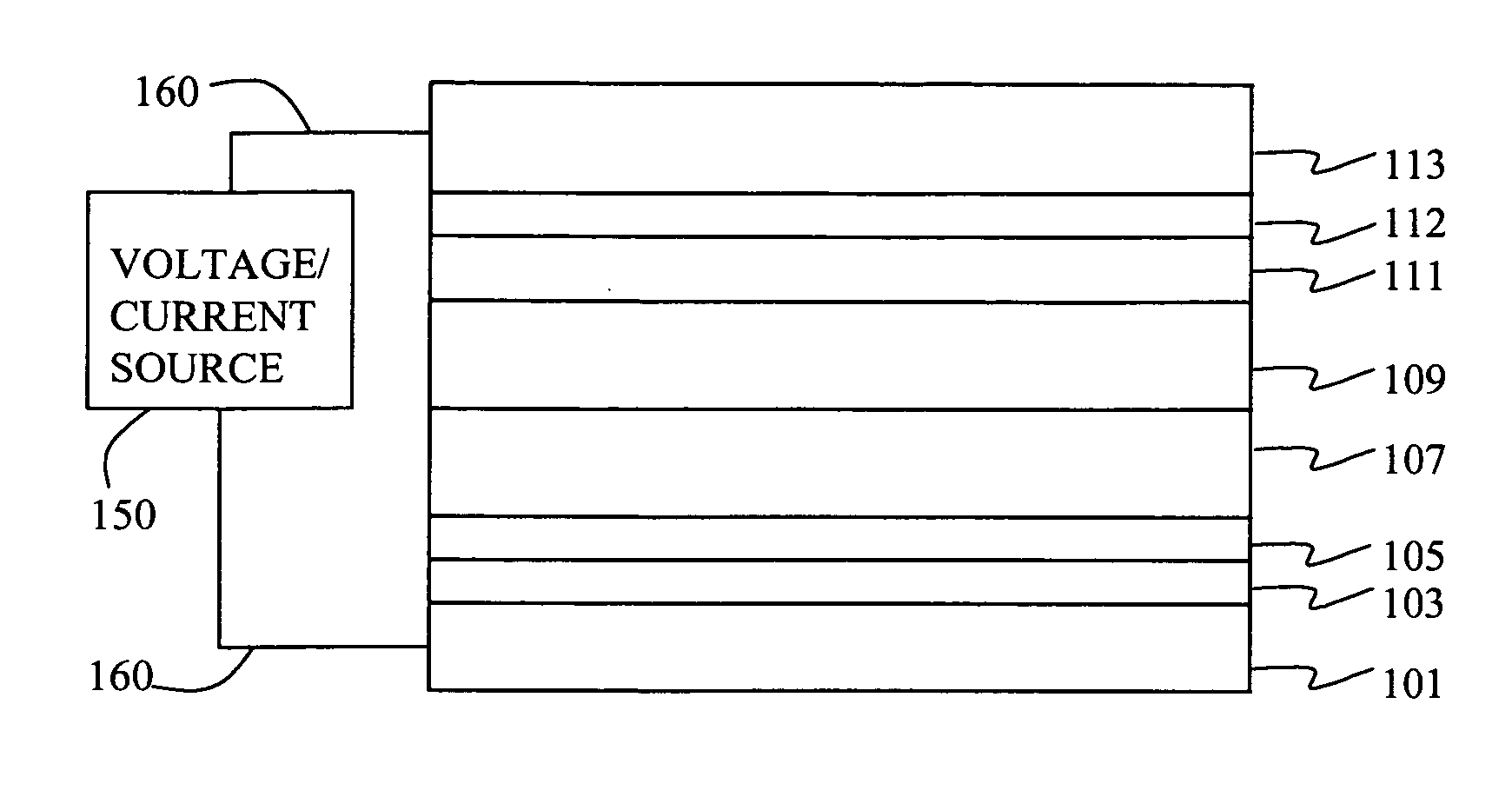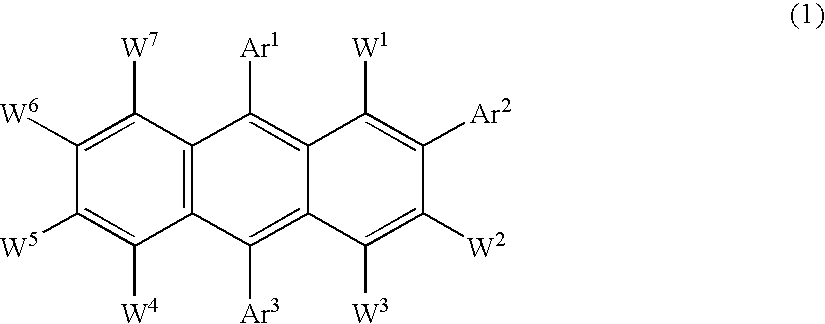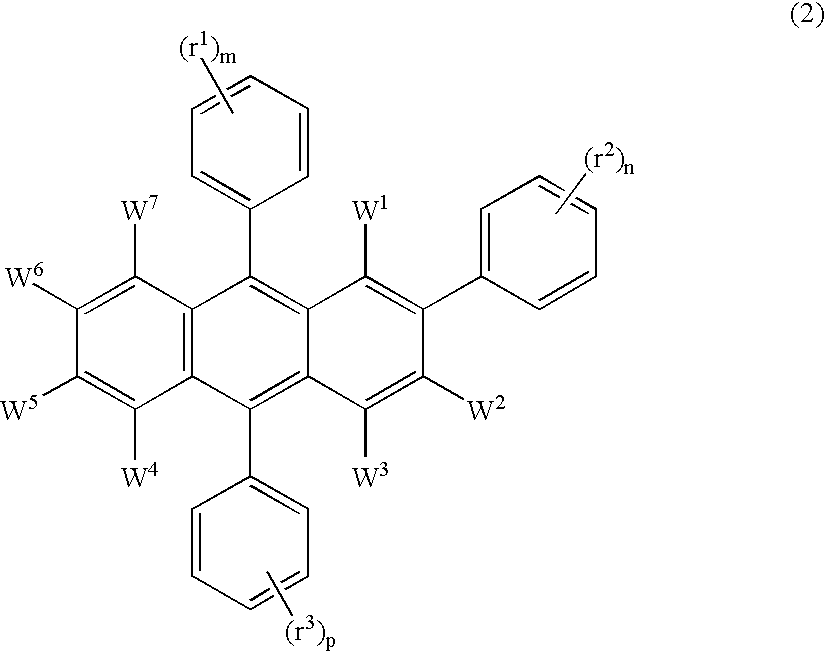Electroluminescent device including an anthracene derivative
an electroluminescent device and anthracene technology, applied in the direction of discharge tube luminescnet screens, organic semiconductor devices, natural mineral layered products, etc., can solve the problems that anthracene described previously may not provide all the desirable embodiments of a host material, and their performance limitations have represented a barrier to many desirable applications, so as to reduce the drive voltage and improve efficiency
- Summary
- Abstract
- Description
- Claims
- Application Information
AI Technical Summary
Benefits of technology
Problems solved by technology
Method used
Image
Examples
example 1
Synthesis of inv-1 (Scheme II).
[0176]
Preparation of 2-(p-methoxyphenyl)anthracene (Int-1).
[0177] A coupling catalyst was prepared by combining 2-chloroanthracene (415 mg, 2 mmol), palladium diacetate (224 mg, 1 mmol) and Sphos (2-(2′,6′-dimethoxybiphenyl)dicyclohexylphosphine, 455 mg, 1.1 mmol) in 20 mL of toluene and stirring the mixture at 35-40° C. for 10 min. The catalyst was added to a mixture of 2-chloroanthracene (21.8 g, 103 mmol) and p-methoxyphenylboronic acid (18.0 g, 118 mmol) and potassium phosphate dihydrate (78.0 g, 340 mmol) in 280 mL of toluene. The reaction temperature was increased from 22° C. to 45° C. over 20 min. with stirring. The temperature was then increased to 55° C.-60° C. for an additional 3 h. An additional amount of catalyst was added (0.2 mol %, prepared in the same way as described above) and the mixture was heated for 2 h at 70° C. The reaction mixture was heated to 100° C. and 130 mL of heptane was added followed by 200 mL of water. The mixture ...
example 2
Electrochemical Redox Potentials.
[0180] Electrochemical redox potentials were determined experimentally by the following electrochemical methods. A Model CH1660 electrochemical analyzer (CH Instruments, Inc., Austin, Tex.) was employed to carry out the electrochemical measurements. Cyclic voltammetry (CV) and Osteryoung square-wave voltammetry (SWV) were used to characterize the redox properties of the compounds of interest. A glassy carbon (GC) disk electrode (A=0.071 cm2) was used as working electrode. The GC electrode was polished with 0.05 μm alumina slurry, followed by sonication cleaning in Milli-Q deionized water twice and rinsed with acetone in between water cleaning. The electrode was finally cleaned and activated by electrochemical treatment prior to use. A platinum wire served as counter electrode and a saturated calomel electrode (SCE) was used as a quasi-reference electrode to complete a standard 3-electrode electrochemical cell. Ferrocene (Fc) was used as an internal ...
example 3
Fabrication of Device 1-1 through 1-4.
[0183] A series of EL devices (1-1 through 1-4) were constructed in the following manner. [0184] 1. A glass substrate coated with a 21.5 nm layer of indium-tin oxide (ITO), as the anode, was sequentially ultrasonicated in a commercial detergent, rinsed in deionized water, degreased in toluene vapor and exposed to oxygen plasma for about 1 min. [0185] 2. Over the ITO was deposited a 1 nm fluorocarbon (CFx) hole-injecting layer (HIL) by plasma-assisted deposition of CHF3 as described in U.S. Pat. No. 6,208,075. [0186] 3. Next a layer of hole-transporting material 4,4′-Bis[N-(1-naphthyl)-N-phenylamino]biphenyl (NPB) was deposited to a thickness of 75 nm. [0187] 4. A light-emitting layer (LEL) at a thickness shown in Table 2a and corresponding to C-1 or Inv-1 (see Table 2a) and including light-emitting material, D-1, at a level of 0.75% of the layer by volume was then deposited. [0188] 5. An electron-transporting layer (ETL) of tris(8-quinolinolato...
PUM
| Property | Measurement | Unit |
|---|---|---|
| thick | aaaaa | aaaaa |
| operating voltages | aaaaa | aaaaa |
| drive voltage | aaaaa | aaaaa |
Abstract
Description
Claims
Application Information
 Login to View More
Login to View More - R&D
- Intellectual Property
- Life Sciences
- Materials
- Tech Scout
- Unparalleled Data Quality
- Higher Quality Content
- 60% Fewer Hallucinations
Browse by: Latest US Patents, China's latest patents, Technical Efficacy Thesaurus, Application Domain, Technology Topic, Popular Technical Reports.
© 2025 PatSnap. All rights reserved.Legal|Privacy policy|Modern Slavery Act Transparency Statement|Sitemap|About US| Contact US: help@patsnap.com



